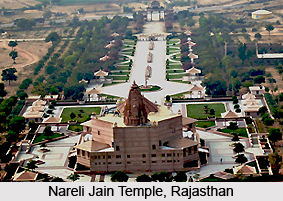 Nareli Jain Temple is a modern Jain temple which is located at a distance of nearly 7 kms away from Ajmer city, Rajasthan and is present on the Main National Highway 8, Kishangarh Bypass. It is based about 128 kms from the western portion of Jaipur and had been constructed by a man named Ashok Patni. Nareli Jain Temple is quite well-known for its elaborate patterns and carvings and the temple complex comprises several shrines and temples, and known as `Shri Gyanodaya Tirth Kshetra`. Some of these shrines are yet under construction. It is said that the erection of the temple had commenced between 1994 and 1995, on account of the divine blessings of the disciple of Acharya Vidya Sagar who was Muni Sudha Sagar. In 2002, gigantic idols manufactured from `ashta-dhatu` or an alloy of eight metals, have been placed in the temple premises. The temple grounds of Nareli Jain Temple are based over the entire hilly region and innumerable devotees throng the temple, particularly the Jain communities, who belong to Digambara sects.
Nareli Jain Temple is a modern Jain temple which is located at a distance of nearly 7 kms away from Ajmer city, Rajasthan and is present on the Main National Highway 8, Kishangarh Bypass. It is based about 128 kms from the western portion of Jaipur and had been constructed by a man named Ashok Patni. Nareli Jain Temple is quite well-known for its elaborate patterns and carvings and the temple complex comprises several shrines and temples, and known as `Shri Gyanodaya Tirth Kshetra`. Some of these shrines are yet under construction. It is said that the erection of the temple had commenced between 1994 and 1995, on account of the divine blessings of the disciple of Acharya Vidya Sagar who was Muni Sudha Sagar. In 2002, gigantic idols manufactured from `ashta-dhatu` or an alloy of eight metals, have been placed in the temple premises. The temple grounds of Nareli Jain Temple are based over the entire hilly region and innumerable devotees throng the temple, particularly the Jain communities, who belong to Digambara sects.
The temple grounds of Nareli Jain Temple consists of 24 temples, each dedicated to the 24 Jain Tirthankaras. Out of the images of all the Jain Tirthankaras, the images of the three Tirthankaras named as Arah Nath Ji, Kunthu Nath Ji and Shri Shanti Nath Ji have been established at the temple. Each of the Tirthankara idols weight about 24 tons, which makes it the heaviest metallic Jain idol in the entire world. The temple is slightly angular in shape and boasts of contemporary architectural pattern.
Visiting Information
One can access the Nareli Jain Temple through roadway, air and railway. One can avail taxis and autos from Ajmer and other local towns. Ajmer junction is the closest railway station and is a significant railway junction with gauge lines. Jaipur International Airport is the nearest airport to Ajmer.
This article is a stub. You can enrich by adding more information to it. Send your Write Up to content@indianetzone.com





















